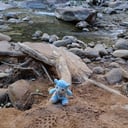Which fact about turtles is not correct?
Turtles have rigid beaks and use their jaws to cut and chew food. Instead of having teeth, which they appear to have lost about 150–200 million years ago, the upper and lower jaws of the turtle are covered by horny ridges. Carnivorous turtles usually have knife-sharp ridges for slicing through their prey. Herbivorous turtles have serrated-edged ridges that help them cut through tough plants. They use their tongues to swallow food, but unlike most reptiles, they cannot stick out their tongues to catch food.
Like other reptiles, turtles lay eggs that are slightly soft and leathery. The eggs of the largest species are spherical while the eggs of the rest are elongated. Their albumen is white and contains a different protein from bird eggs, such that it will not coagulate when cooked. Turtle eggs prepared to eat consist mainly of yolk. In some species, temperature determines whether an egg develops into a male or a female: a higher temperature causes a female, a lower temperature causes a male. Large numbers of eggs are deposited in holes dug into mud or sand. They are then covered and left to incubate by themselves.
More Info:
en.wikipedia.org









